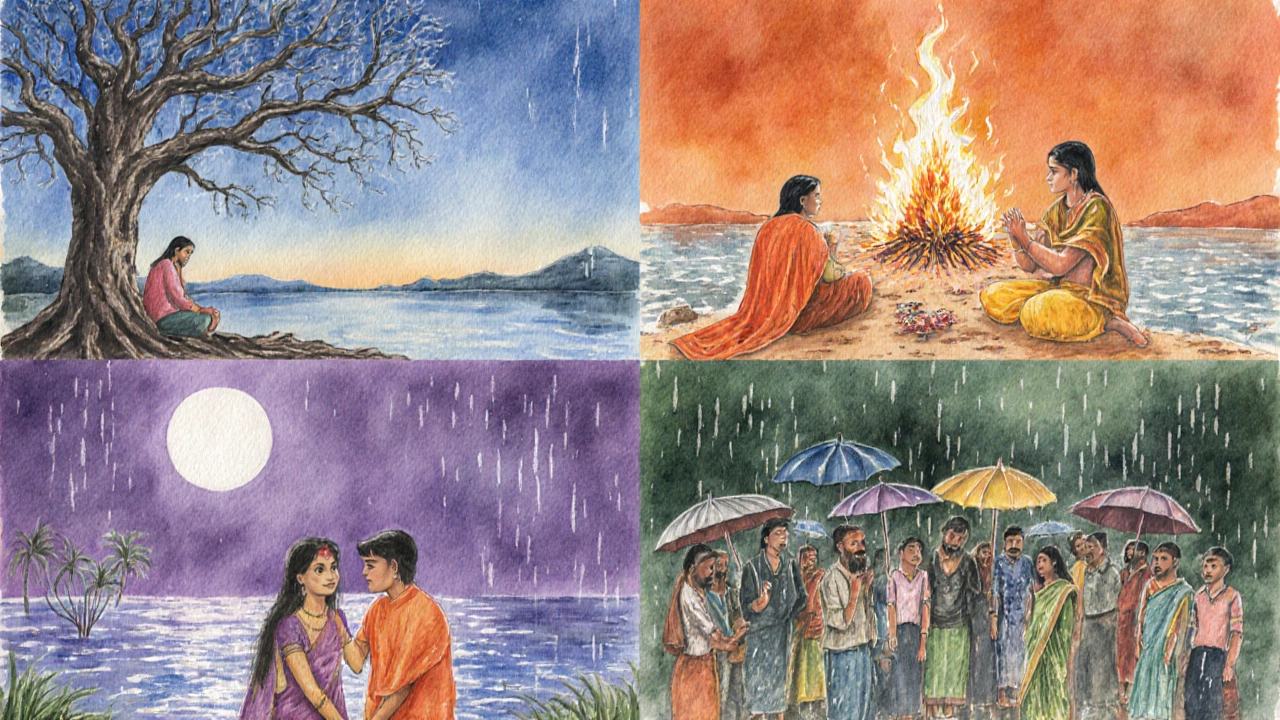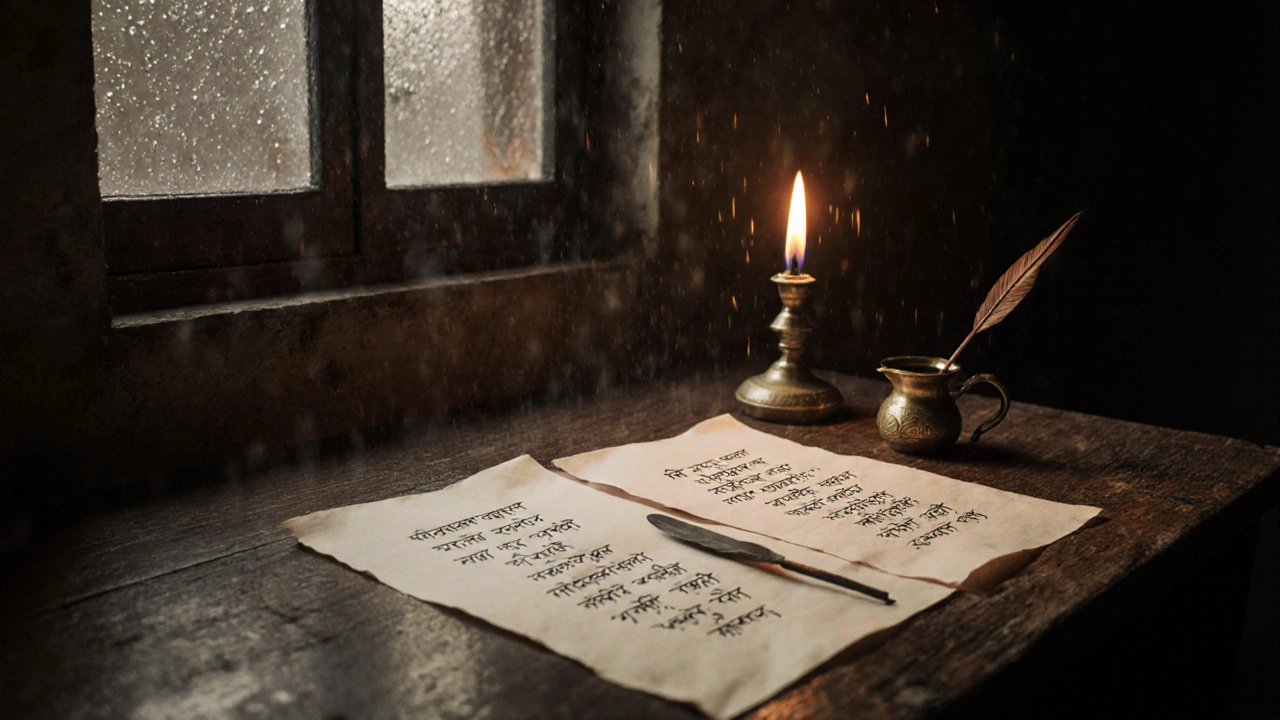Indian Melancholy Poetry Quiz
Test Your Knowledge of Indian Melancholy Poetry
Identify the correct poetry type based on the description provided. Each question has only one correct answer.
Ever wondered what you’re really reading when a poem drips with sorrow, loss, or longing? In Indian literary traditions there’s a whole family of names for those heart‑heavy verses. Knowing the proper terms not only helps you search for the right poems, it also deepens your appreciation of the cultural context behind the grief.
What exactly qualifies as a melancholy poem is a verse that deliberately evokes a sense of sadness, nostalgia, or existential yearning. It often uses vivid imagery, slow rhythms, and personal confession to convey inner turmoil.
In Western literature you might label these works “lament,” “elegy,” or “dirge.” Indian writers, however, coined specific names that tie the emotion to language, mythology, and regional tradition. Below we break down the most common Indian categories, the languages that nurture them, and a few classic examples.
Key Indian Categories of Sad Poetry
While each term overlaps in mood, they differ in focus and historical usage.
- Udasi Kavita (‘poetry of melancholy’) is a broad label for verses that explore personal despondency and emotional numbness. It appears in Hindi, Urdu, and Punjabi folk traditions.
- Shok Kavita (‘lament poetry’) focuses on grief after a specific loss-death, separation, or disaster. The form dates back to Vedic hymns mourning the death of revered figures.
- Virah Kavita (‘poetry of separation’) centers on the ache of lovers kept apart, often invoking mythic lovers like Radha‑Krishna. It flourished in medieval Bhakti literature.
- Karuna Kavita (‘compassionate poetry’) blends sorrow with empathy, usually reflecting on collective suffering, such as famine or war. Modern Bengali poets like Jibanananda Das used this style.
Historical Roots and Regional Flavors
India’s linguistic diversity means each language builds its own sad‑poetry lexicon. Here’s a snapshot of the most influential traditions:
| Poetry Type | Primary Language(s) | Typical Theme | Historical Era |
|---|---|---|---|
| Udasi Kavita | Hindi, Urdu, Punjabi | Personal despondency, existential angst | 18th‑19th century folk |
| Shok Kavita | Sanskrit, Hindi | Loss of a loved one, mourning rituals | Vedic & Classical period |
| Virah Kavita | Hindi, Bengali, Gujarati | Longing for absent lover or deity | 12th‑16th century Bhakti movement |
| Karuna Kavita | Bengali, Malayalam, Tamil | Social tragedy, collective pain | 20th‑century modernism |
How to Identify the Type When Reading
Spotting the label isn’t always obvious, but a few cues help:
- Keyword clues: Words like “shok,” “virah,” or “udasi” often appear in the title or opening line.
- Contextual focus: If the poem mourns a death, it’s likely Shok. If it dwells on longing, look for Virah.
- Stylistic markers: Karuna poems tend to use collective pronouns (“we,” “our”) and societal imagery, whereas Udasi is more introspective.
- Historical allusion: References to mythic lovers point to Virah; mentions of rituals or funeral rites hint at Shok.

Classic Examples Across Languages
Below are short excerpts that illustrate each category. Notice how the mood, diction, and cultural symbols shift.
- Udasi Kavita (Hindi): “अँधेरे में बँध है दिल, आवाज़ नहीं कोई, बस उदासी की स्याही लिपती है इन ख़ुशनुमा सपनों पर।” - Anonymous folk writer.
- Shok Kavita (Sanskrit): “निधनस्य शोकः स्वरुपेण हृदैः, शोकनादेन स्रावयन्ति यः ध्वनिर्मृदु” - From the Rig‑Veda lament for King Pradhyumna.
- Virah Kavita (Bengali): “ভোরের আলোয় তবু রাঁধা স্বপ্ন, তব মধুর হাসি ক্ষণিকের মতো জুড়ি।” - Rabindranath Tagore, “Bebohar” collection.
- Karuna Kavita (Tamil): “எழுந்திருந்து புல் பசுமை நொறுங்கும், கண்ணீர் சொட்டும் துயர் நாட்டு காலம்.” - Subramania Bharati, “Kavitai.”
Why Knowing the Names Matters for Readers and Writers
Understanding these labels does more than satisfy curiosity. For a reader, it offers a roadmap to find poems that match your current mood-whether you need a quiet lament (Shok) or a broader social reflection (Karuna). For a writer, using the right term signals intent to your audience and aligns your work with a literary lineage that can enrich critical reception.
Search engines also favor precise terminology. Typing “Udasi Kavita pdf” yields curated folk collections, while “Shok Kavita anthology” brings academic editions. Knowing the exact term makes your research faster and your citations tighter.
How to Explore More Indian Melancholy Poetry
Here’s a quick checklist to deepen your dive:
- Identify the language you’re comfortable with (Hindi, Bengali, Tamil, etc.).
- Search using the specific poetry type name plus “poems” or “collection.”
- Visit digital libraries like Digital Library of India or Sahitya Akademi for curated anthologies.
- Listen to audio recitations on platforms like YouTube; hearing the cadence often amplifies the melancholy.
- Join online forums (e.g., Reddit r/IndianPoetry) to ask for recommendations based on mood.

Common Misconceptions
People sometimes think all sad Indian poems belong to a single genre. In reality, the four categories we covered-Udasi, Shok, Virah, Karuna-each carry distinct cultural baggage. A ‘Virah’ poem may sound wistful but rarely delves into the communal tragedy that defines ‘Karuna.’ Mixing them up can dilute the emotional impact you’re after.
Another myth: “Sorrowful poetry is outdated.” Modern Indian poets still write in these traditions, often blending them with contemporary forms like free verse or spoken word. Look for recent collections by poets such as Anamika (Hindi) who reimagines Udasi in urban settings.
Quick Reference Cheat Sheet
| Type | Core Emotion | Typical Language | Key Example |
|---|---|---|---|
| Udasi Kavita | Personal melancholy | Hindi, Urdu | Anonymous folk verses |
| Shok Kavita | Grief over loss | Sanskrit, Hindi | Rig‑Veda lament |
| Virah Kavita | Loving separation | Bengali, Gujarati | Tagore’s “Bebohar” |
| Karuna Kavita | Collective sorrow | Tamil, Malayalam | Bharati’s “Kavitai” |
Wrap‑up: Choose the Right Name for Your Mood
Whether you’re looking for verses to echo your own heartache or you’re a writer aiming to place your poem in a tradition, the four Indian categories give you a clear map. Drop a specific term into your search bar, explore the classic anthologies, and let the centuries‑old sorrow speak to you.
What is the difference between Udasi and Shok poetry?
Udasi Kavita focuses on an ongoing, personal sense of melancholy, often without a specific triggering event. Shok Kavita, by contrast, centers on a concrete loss-like death or separation-and usually follows ritual mourning conventions.
Can a poem belong to more than one melancholy category?
Yes. Many modern poets blend themes, e.g., a Virah poem that also expresses collective Karuna. The categorization is flexible, but the dominant mood usually dictates the label.
Where can I find free collections of Udasi Kavita?
Websites like the Digital Library of India and the Sahitya Akademi archive host PDFs of folk Udasi collections. Searching for ‘Udasi Kavita PDF’ yields downloadable anthologies.
Is Karuna Kavita only about social issues?
Primarily, Karuna Kavita reflects collective suffering-famine, war, displacement-but poets also use it to explore personal empathy within a broader social frame.
How do I write my own melancholy poem using Indian terminology?
Start by choosing a specific type (Udasi, Shok, Virah, or Karuna). Identify the core emotion, then select language‑appropriate imagery-e.g., monsoon rain for Udasi, funeral pyre for Shok. Follow traditional meter if you want authenticity, or use free verse for a modern twist.
